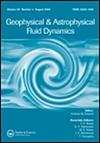孤立波理论中的奇迹、误解和疑点
IF 1.1
4区 地球科学
Q3 ASTRONOMY & ASTROPHYSICS
Geophysical and Astrophysical Fluid Dynamics
Pub Date : 2019-08-20
DOI:10.1080/03091929.2019.1654471
引用次数: 0
摘要
在一个拥有价值数十亿美元的粒子加速器和火星探测器的时代,令人惊讶的是,孤独的波是由一个骑在马背上的人发现的,他没有任何工具,只有自己的眼睛。一个半世纪后,在一次海滩度假中,人们在海洋中发现了更复杂的脊状结构,即所谓的超椭圆双多余弦波。逆散射法是通过求解一系列纯线性方程来求解非线性偏微分方程,它是量子理论和流体力学的结合,产生于一群随机分配到同一办公室的不同学科的博士后之间非正式的、非结构化的对话(即偷懒)。非线性孤立波和线性正弦波都能很好地近似于椭圆体情况下的余弦波。它总是并且精确地是孤立波的叠加,即使在它是无穷小正弦波的极限下也是如此。孤立波的历史和科学就像埃舍尔(m.c. Escher)的画作一样令人迷惑。在这里,我们无法在如此简短的一篇文章中对这些深奥的问题作出理解;相反,我们努力揭示这些主题的美丽和意想不到,让读者有理由在我们引用的更全面的评论和书籍中追求这些主题。此外,我们强调“盲点”(盲点),误解和惊喜,科学的社会学和认识论。的确,失败的理论、盲点、意外发现和认知跳跃(跳跃式进步)是科学的特征。火车的发明也是火车残骸的发明。工程学从每次灾难中学习,科学也应该如此。报道非线性波的高度非线性历史不是不尊重过去,而是用建设性的谨慎取代科学的宿命论。我们并不比斯科特·罗素(Scott Russell)、斯托克斯(Stokes)或朗道(Landau)更聪明或更开明,但我们可以从他们的失败和误解中学习,就像从他们的成功中学习一样。本文章由计算机程序翻译,如有差异,请以英文原文为准。
Miracles, misconceptions and scotomas in the theory of solitary waves
ABSTRACT In an age of billion dollar particle accelerators and Mars rovers, it is surprising that solitary waves were first discovered by a man on horseback with no tools but his own eyes. A century and a half later, more complicated patterns of ridges, so-called hyperelliptic two-polycnoidal waves, were discovered in the ocean during a beach vacation. The inverse scattering method, which solves nonlinear partial differential equations through a sequence of solving purely linear equations, is a blend of quantum theory and hydrodynamics that arose from informal, unstructured conversations (i.e. goofing off) among a group of postdocs from different disciplines who were randomly assigned to the same office. The cnoidal wave in the lemniscate case is well-approximated by a nonlinear solitary wave and equally well approximated by a linear sine wave. It is always and exactly the superposition of solitary waves even in the limit in which it is an infinitesimal sine wave. The history and science of solitary waves has the disorienting quality of an M. C. Escher drawing. Here, we cannot give an understanding of these deep subjects in so brief an article; rather we strive to unveil the beauty and unexpectedness of these topics to give the reader a reason to pursue these in the much more comprehensive reviews and books we cite. Further, we stress the “scotomas” (blind spots), misconceptions and surprises, the sociology and epistemology of science. It is true that failed theories, scotomas, serendipity and cognitive saltation (progress in jumps) is characteristic of science. It is also true that the invention of the train was the invention of the train wreck. Engineering learns from each disaster and science should do the same. The highly nonlinear history of nonlinear waves is reported not to disrespect the past but to replace scientific fatalism with a constructive wariness. We are not smarter or more enlightened than Scott Russell or Stokes or Landau, but we can learn from their scotomas and misconceptions as much as from their triumphs.
求助全文
通过发布文献求助,成功后即可免费获取论文全文。
去求助
来源期刊

Geophysical and Astrophysical Fluid Dynamics
地学天文-地球化学与地球物理
CiteScore
3.10
自引率
0.00%
发文量
14
审稿时长
>12 weeks
期刊介绍:
Geophysical and Astrophysical Fluid Dynamics exists for the publication of original research papers and short communications, occasional survey articles and conference reports on the fluid mechanics of the earth and planets, including oceans, atmospheres and interiors, and the fluid mechanics of the sun, stars and other astrophysical objects.
In addition, their magnetohydrodynamic behaviours are investigated. Experimental, theoretical and numerical studies of rotating, stratified and convecting fluids of general interest to geophysicists and astrophysicists appear. Properly interpreted observational results are also published.
 求助内容:
求助内容: 应助结果提醒方式:
应助结果提醒方式:


